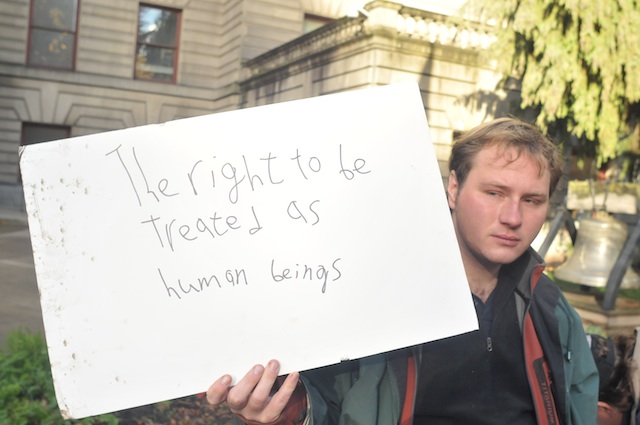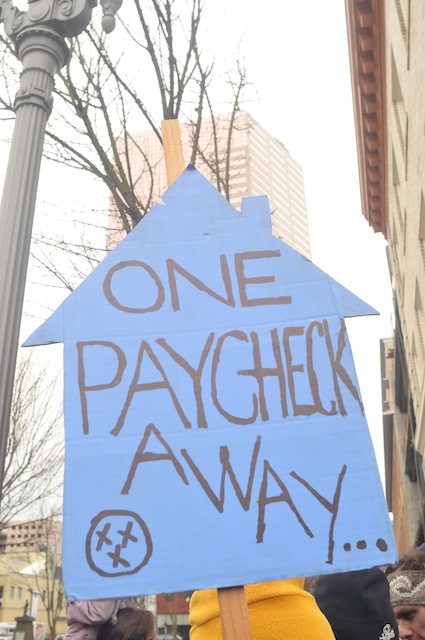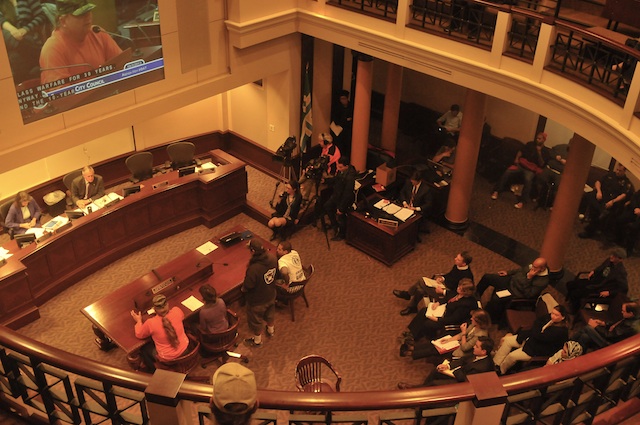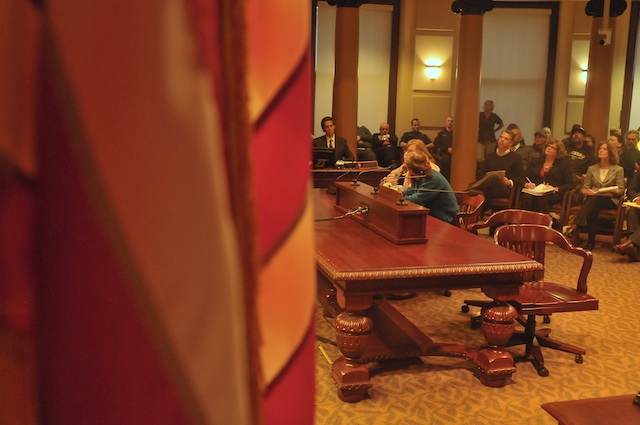Palo Alto’s recent ban on Vehicle Habitation is another nail in the Gated Community Fence plague that is currently sweeping the country. In Santa Cruz, Mayor Bryant’s hand-picked coterie of bigot-enablers, the Citizens Task Force on Public Safety has come up with preliminary recommendations explicitly designed to drive homeless people away and intensify the criminalization process here (See http://www.cityofsantacruz.
HUFF meets today to plan protests against the Shrinking Sidewalks (11 AM Sub Rosa at 703 Pacific in Santa Cruz). The Street Performers Guild meets 11 AM Saturday 10-19 at India Joze restaurant at 418 Front St.. Sunday’s follow-up Tour of Shame is slated for the next day 1 PM Sunday 10-20 in front of Forever Twenty-One at Soquel and Pacific. Speak Out at City Council Tuesday 5 PM 10-22 809 Center St. The ordinances and possible CD protests begin October 24th.
Silicon Valley Trailer Park Residents Fight To Stay
by
EXTENSIVE COMMENTS AND AUDIO AT http://www.npr.org/2013/10/15/
Sunny Palo Alto, Calif., is awash in multimillion-dollar homes, luxury Tesla electric cars and other financial fruits from a digital revolution the city helped spark. The Silicon Valley city is home to Stanford University, at least eight billionaires, and one mobile home park.
Now, Buena Vista Mobile Home Park — one of the largest and one of the few remaining affordable housing options here — is threatened with closure. The owners want to to a developer who plans to build luxury apartments for the high-tech corridor’s growing workforce. The park’s low-income, mostly Latino residents are fighting to stay in their community and to keep their kids in one of California’s best school districts.
The fight shows the less-publicized underbelly of Silicon Valley’s incredible successes: unequal access to education, and the marginalization of some low-income workers.
A Good Education
“Most of us don’t really know where we’d go” if the park closed, says 28-year-old Erika Escalante, who grew up at Buena Vista and now lives in a mobile home there with her husband and 6-year-old son. “With rents in Palo Alto, it’s just impossible,” she says.
Quality public education is the main reason many of the park’s residents are fighting to stay. The Palo Alto schools among more than 1,000 districts in the state, and test scores for all ethnic groups have regularly exceeded statewide averages.
Escalante was the first in her family to graduate from college. Her sister and brother are now following her lead. Escalante’s dad worked as a janitor. She says he moved the family to Buena Vista largely because of the schools.
“He felt like we were getting the best education that he could possibly offer to us,” Escalante says. “I mean, we know that historically Hispanics are kind of disadvantaged. There’s that big education gap. And to be able to have access to that education, I mean, you can’t put a price there. We want to be able to succeed, you know, kind of like that American dream. Education is a big part of that.”
An Airstream To Call Home
Buena Vista is home to more than 400 predominantly low-income residents, more than 80 percent of them Latino.
Ringed with a jumble of potted plants, a silver ’70s-era Airstream trailer has been home to Jennifer Tello for most of her 12 years.
“My mom works cleaning houses, and my dad works construction,” she says. Jennifer’s mom is busy getting food for her baby sister before heading off to work. Jennifer says her parents struggled to find a place in the Bay Area that’s safe, affordable and has quality schools.
“They’re really good schools. My mom works really hard, and so does my dad. Sometimes they don’t have enough time to spend with us. I’m really happy that they’re really hard working. And they encourage me to work hard, so I [could] have a better job,” she says.
The park’s owners, Toufic and Eva Jisser, have petitioned the city of Palo Alto to close shop. They want to sell the land to Prometheus Real Estate Group, which wants to build 180 luxury apartments on the site. “My client has a constitutional right to exit the rental business,” says Margaret Ecker Nanda, the owners’ lawyer. Prometheus officials declined to comment.

Eric Westervelt/NPR
The Value Of Diversity
Jennifer Tello attends a nearby middle school. “I don’t want to move and start all over and find new friends,” she says.
The PTA, the school board, and some parents have taken action to back the park’s residents. They’ve offered supportive resolutions, organizing space, and their time. Nancy Krop, a civil rights attorney, is one of those parents. She says diversity, fairness and justice are at stake.
“I want every child to have the opportunity that my son’s going to have — and that I had,” Krop says. These kids at Buena Vista “want the world, and know they need a Palo Alto education to get it.”
Krop says she was attending a City Council meeting when one Buena Vista mother spoke up. “She mentioned that she made a living cleaning other peoples’ houses. And she asked the City Council to please allow her family to keep their home at the mobile home park because she felt that if her daughter went through the Palo Alto schools, her daughter would not grow up to clean other peoples’ homes,” says Krop. “I was really struck by that.”
Krop’s fifth-grade son attends nearby Barron Park Elementary, where 35 percent of the students are Latino and about half the students are learning English. She says the benefits of that diversity are key for her family in a city that is incredibly affluent and still mostly white.
Related Stories

“My son has gone on play dates to homes where he found out his friend didn’t have a bedroom. His friend sleeps on a couch. He didn’t even know that that was how some kids grow up. You learn what they don’t have; you learn the richness of what they do have too — the strength of their community and culture and heritage,” she says.
Trying To Stop The Sale
The residents are asking the city to help stop the sale. They point out that city planning documents list the mobile home park as a key source of affordable housing and “encourages its preservation.” But ultimately, that may not mean much legally. Palo Alto city attorneys say the mobile home park is not counted as part of a regional affordable housing plan required by the state.
The city has twice rejected the owners’ application to close the park, largely due to incomplete details in its relocation benefits package. “There is recognition of the desire to preserve the park,” says city spokeswoman Claudia Keith. But with soaring private property values in Silicon Valley, she says there may be little the city can do. The park’s residents can appeal any final decision the city makes to an independent hearing officer.
The Buena Vista residents’ group, with help from legal aid and affordable housing organizations, offered to buy the property for $14.5 million. The owners rejected that offer.
The owners’ attorney Margaret Nanda says her client has every right to cash in on booming property values and retire. The owner was offered more than $30 million for the 4.5-acre lot. “He is not a social agency or a nonprofit. He’s a private business operator who wants to sell his property,” she says.
Nanda says her client will compensate tenants fairly under city law, but equivalent quality schools are not part of that package. “There is absolutely no right to a Palo Alto education under the [city] ordinance” for converting a mobile home park, Nanda says. “The ordinance says they are to be relocated to comparable housing. And then the ordinance references a number of things, but education is not one of them.”
‘Squeezed’ By Rising Housing Costs
Amado Padilla, a professor at the Stanford Graduate School of Education, has teamed up with the medical school to study the education, housing and health care challenges the Buena Vista residents face. Padilla notes that the residents’ struggle highlights a less-discussed part of the valley’s thriving high-tech economy: It’s driving tremendous job growth, but surging housing prices are forcing more and more working people to the margins.
“Just like police and firemen and also teachers cannot afford to live in Palo Alto, these people could not afford to live in Palo Alto if it were not for places like the mobile park home. Our service workers are getting squeezed in all kinds of directions because of the tech fields in our areas,” Padilla says.
Silicon Valley is particularly hard hit by sky-high housing prices. But the problem is serious across large swaths of America’s most populous state. New research by the Center on Poverty and Inequality at Stanford says that rising housing costs are pushing more families into poverty. According to the center’s new , 22 percent of Californians are in poverty.
At a recent potluck dinner celebrating diversity at the Barron Park school, a few blocks from the mobile home park, kids, parents and teachers ate, talked and heard songs and performances.
It’s clear the Buena Vista residents are not going away silently. With few resources of their own, they are vowing to fight to stay in the community — and schools — that they love.
But this may all come down to the hard reality of money: Buena Vista residents pay about $700 a month in rent. Palo Alto’s average monthly rental is nearly four times that amount. And the average home price here is edging up to nearly $2 million.
A FEW COMMENTS (for more go to the website):
They’re just trying to keep living there, which you’ve said you can understand. And they’re trying to do it legally.
What I don’t understand is why some folks will support owners and the wealthy when they seek favors from government, but denigrate renters and the poor who do so for their “entitled” “squatter mentality.”
The construction costs are being paid by $800 million in seat and luxury box sales, along with a 20-year, $220 million naming rights agreement with Levi Strauss and Co. announced in May.
The owner has the right to sell the property, but the new owners must obey whatever restrictions the local government has placed on what they can do with it, and that will affect the price. If the area is currently zoned as a trailer park, then the new owner will be seeking a change in zoning. Whether or not that is granted is a matter of political influence; the money of the developers vs the political action of those wanting to retain economic and social diversity.
Yes, another approach (or simultaneous approach) is to raise the price difference. Raising an additional 15 million will take some time, though. Letting the developer know that the exemption and permitting process will not sail through is one way of gaining that additional time.
Can’t you retire on $14.5 million and give the land to the residents?
Austin OK’s Loaves & Fishes’ Sanctuary Camp; Santa Cruz Moves to Criminalize
To: HUFF yahoo groups <huffsantacruz@yahoogroups.com
Our local monopoly homeless Nanny–the Homeless (Lack of) Services Center is spending it’s money on fences, security gates, “no impact” zone enforcement, & driving away homeless people during the day from “their” Center. They could be restoring lockers, expanding space and services, & advocating for the rights of homeless people before a bigot-heavy City Council. The Bryant-Robinson Council has intensified its war on the poor this year with curfews, expanded forbidden zones, increased powers to expel homeless people (anyone actually) from parks and elsewhere, unprecedented stay-away orders, and new laws that shaft street performers, artists, and vendors (as of October 24th).
Nor have most churches been helpful–though a small number are housing 20 people a night total.
Brent Adams Sanctuary Camp program has been pilloried by the usual tribe of trolls in the Sentinel (See comments after http://www.santacruzsentinel.
County approves plans for RV park for homeless
American-Statesman Staff
The $8 million development, in eastern Travis County, on Hog Eye Road near Decker and Loyola lanes, abuts a pair of subdivisions whose residents have largely opposed the project. Formerly homeless people moving into the development would pay rents of $90 to $375 a month for small homes in a community that would be fenced in and include a medical clinic and a 3-acre garden.
“I’m ecstatic about it. It’s a nine-year dream come true,” said Mobile Loaves & Fishes president Alan Graham.
With the commissioners’ blessing in hand, the project needs only administrative approvals, which officials said could happen within the week.
Graham said his organization still needs to raise more than $2 million as part of the $6 million needed for the first phase of the project. He expects those funds to be raised by the end of the year as many potential donors have been holding out for the commissioners’ approval of the development plans.
Residents could start moving in by the end of 2014 and the development, called Community First Village, could be done by the end of 2015, Graham said.
Neighbors said they were concerned about the safety of living next to a development geared toward homeless people and what it would do to their property values.
With a packed meeting room with more than 50 supporters of the project and about a dozen people from neighborhoods near the planned development, commissioners heard more than two hours of discussion before their vote.
The city of Austin’s zoning and platting commission previously approved the plans in July. The project, outside Austin’s city limits, doesn’t require City Council approval.
The Austin nonprofit Mobile Loaves & Fishes has tried for nearly a decade to create an RV park for homeless people. Some highlights include:
- 2008: The City Council agrees to lease 11 acres on Harold Court in East Austin to the nonprofit for the project, but backs off when neighbors resoundingly object.
- 2010: The city eyes 16 acres near the airport for the RV park, but nixes the idea when the Federal Aviation Administration objects.
- 2010: The city considers using 24 acres near Burnet Road and Braker Lane in North Austin for the project. Neighbors balk, saying a long-term plan for the area calls for dense, urban development, not mobile homes.
- 2013: Mobile Loaves & Fishes plans the project for 27 acres it owns in eastern Travis County. The project is OK’d by an Austin zoning board in July and county commissioners on Tuesday.













